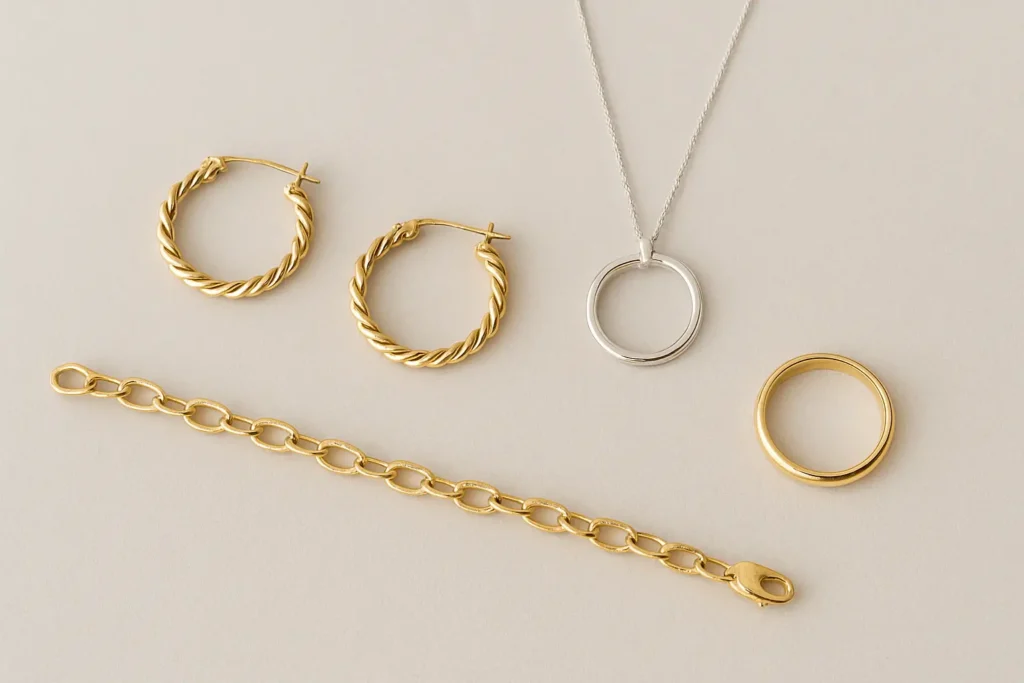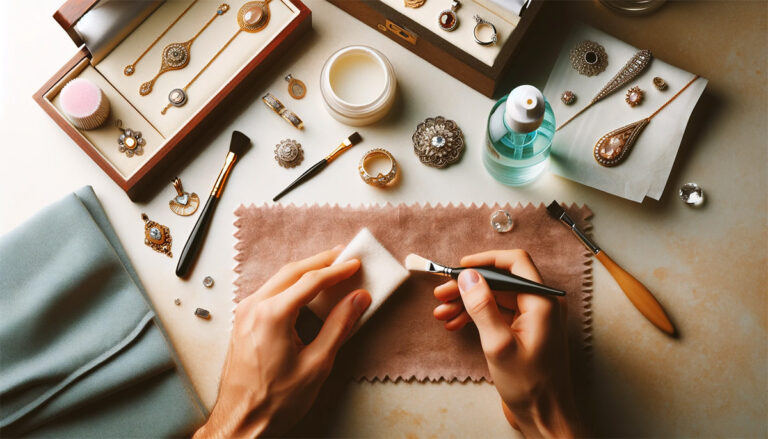
Handmade jewelry isn’t just an accessory—it’s an expression of artistry, individuality, and personal meaning. Whether you’ve purchased a handcrafted ring from Make Made Jewelry or wear sentimental artisan pieces passed down through family, proper care will keep your jewelry stunning for decades. This ultimate guide walks you through expert-approved methods to clean, store, and preserve your handmade treasures with confidence.
Table of Contents
Understanding Handmade Jewelry Materials

Unlike mass-produced pieces, handmade jewelry is crafted with individual attention, intentional details, and ethically curated materials. Whether you purchase from a local artisan or a boutique such as Make Made Jewelry’s collection, every piece has its own unique energy and structure.
Artisans often use premium metals like sterling silver, gold, and platinum, along with natural gemstones, pearls, and enamel work. Because each material has its own sensitivities, your care routine must reflect the craftsmanship behind the piece.
Organic components like wood, leather, or pearls react differently to moisture and chemicals, while precious metals may tarnish or scratch when stored improperly. Understanding these basic material differences helps ensure you protect your jewelry at its core.
Daily Care Essentials

Your daily habits have the greatest impact on the longevity of handmade jewelry. Fortunately, adopting a few simple routines can prevent most wear and tear before it ever begins.
The “Last On, First Off” Rule
Always put your jewelry on last after applying lotions, perfumes, hair products, or cosmetics. These contain chemicals that dull metals and damage porous gemstones.
Remove Jewelry During Activities
Take off your jewelry before exercising, swimming, gardening, cooking, or cleaning. Chlorine, sweat, chemicals, and physical impact are among the most common causes of damage.
Rotate Your Pieces
Wearing the same necklace or ring every day accelerates wear. If you own multiple handmade pieces, rotate them to maintain condition and enjoy more variety in your style.
Quick Inspections Before Wearing
Spend 10 seconds checking for loose stones, bent links, or worn clasps. Early detection prevents major, costly repairs later.
Safe At-Home Cleaning Techniques

Cleaning handmade jewelry at home is completely safe when done correctly—and often helps maintain brilliance better than infrequent professional cleanings.
1. Mild Soap & Water Method
This is the safest method for most pieces. Mix a few drops of gentle, fragrance-free dish soap with warm water. Soak for 5–10 minutes, then scrub with a soft brush and pat dry.
2. Polishing Cloths
Specialty cloths designed for metals like silver or gold help remove tarnish without damaging delicate textures. Avoid using one cloth for multiple metals to prevent residue transfer.
3. Avoid Ultrasonic and Steam Cleaning
Although powerful, ultrasonic vibrations can loosen stones or crack delicate materials. Steam cleaning can also shock heat-sensitive gemstones. See guidance from professionals such as GIA’s jewelry cleaning guide.
Proper Storage Solutions

Thoughtful storage is key to preventing tangling, scratching, moisture buildup, and tarnish—especially in humid regions.
Individual Compartments
Store each piece separately in fabric-lined compartments. Hard gemstones like diamonds can scratch softer stones or metals if stored together.
Anti-Tarnish Protection
Use anti-tarnish strips or pouches for sterling silver pieces. Replace these strips every 6–12 months for maximum effectiveness.
Avoid Bathrooms & Humid Spaces
Steam and moisture accelerate tarnish and weaken settings. Always store jewelry in a cool, dry, shaded area.
Travel Cases
When traveling, use padded jewelry rolls or cases. Never toss jewelry into bags where chains can knot or gemstones can chip.
Metal-Specific Care Tips

Sterling Silver
Silver naturally tarnishes, but regular wear actually helps prevent it. Clean lightly with a silver polishing cloth and store in anti-tarnish bags.
Gold
Gold doesn’t tarnish but can collect oils and debris. Clean with warm water and mild soap. White gold may require rhodium replating every few years for shine.
Platinum
Platinum develops a patina over time—many people love this natural finish. It can be professionally polished if you prefer a bright shine.
Alternative Metals (Copper, Brass, Titanium)
Copper and brass may develop a natural patina. You can polish them to maintain brightness or enjoy their aged look. Titanium requires very minimal care.
How to Care for Gemstones

Hard Gemstones (Diamonds, Rubies, Sapphires)
These stones are durable but still vulnerable to impact. Clean gently with soap and water. Avoid ultrasonic cleaning if heavily included.
Medium-Hard Stones (Topaz, Garnet, Quartz)
These resist scratches but should be stored separately from harder stones. Gentle cleaning is recommended.
Delicate Stones (Opals, Pearls, Turquoise, Emeralds)
These require the most caution:
- Pearls should never be submerged—wipe with a damp cloth only.
- Opals can crack from sudden temperature changes.
- Emeralds often contain oils—avoid harsh cleaners.
For more gemstone-specific insight, refer to reputable resources such as International Gem Society’s care guide.
Common Mistakes to Avoid

- Over-cleaning: Excessive scrubbing wears down metal over time.
- Wearing jewelry in water: Chlorine is notoriously damaging to metals and stones.
- Using harsh chemicals: Bleach, ammonia, and cleaners can permanently damage jewelry.
- Storing pieces together: Mixing metals and gemstones causes scratches and tangling.
- DIY fixes: Homemade repairs often cause more harm than good—especially with handmade jewelry.
When to Seek Professional Care

Even with excellent home care, professional attention is essential from time to time.
Annual Checkups
Have your jewelry inspected once a year. Jewelers can tighten prongs, clean hard-to-reach areas, and check structural integrity.
Signs You Need Immediate Attention
- Loose stones
- Broken clasps or links
- Dull gemstones that won’t brighten with cleaning
- Bent prongs
Rhodium Replating & Polishing
White gold often needs replating to keep its icy sheen. Polishing services restore brilliance to frequently worn pieces.
Seasonal Care Tips

Weather plays a surprising role in jewelry preservation.
Summer
Humidity accelerates tarnish. Clean silver more often and avoid wearing delicate pieces outdoors with sunscreen or bug spray.
Winter
Dry indoor heating can dehydrate opals, pearls, and amber. Store in slightly humid environments and avoid sudden temperature changes.
Spring & Fall
Seasonal transitions are perfect times for reorganizing storage, refreshing anti-tarnish strips, and completing annual cleanings.
Restoration & Repair Advice

Choose a Skilled Jeweler
Handmade jewelry requires a craftsperson who understands custom work, not just mass-produced repairs. Always check their portfolio before hiring.
Document the Piece
Photograph your jewelry before handing it over for repairs—this protects both you and the jeweler.
Know the Limits of Restoration
Some older or delicate pieces cannot be restored perfectly. A professional will help you determine what’s safe.
Repair vs Replacement
For handmade pieces—especially sentimental ones—repair is typically more valuable than replacement, since no two handmade designs are identical.
Your Handmade Jewelry Deserves Lifelong Care
Caring for handmade jewelry is an investment in beauty, longevity, and memory. With a combination of daily mindfulness, safe cleaning routines, and occasional professional help, your pieces will remain stunning for generations.
Whether it’s a handcrafted ring, a custom necklace, or a one-of-a-kind heirloom, your jewelry from Make Made Jewelry deserves preservation as thoughtful as its creation. Treat it well, and it will continue telling your story for a lifetime.

